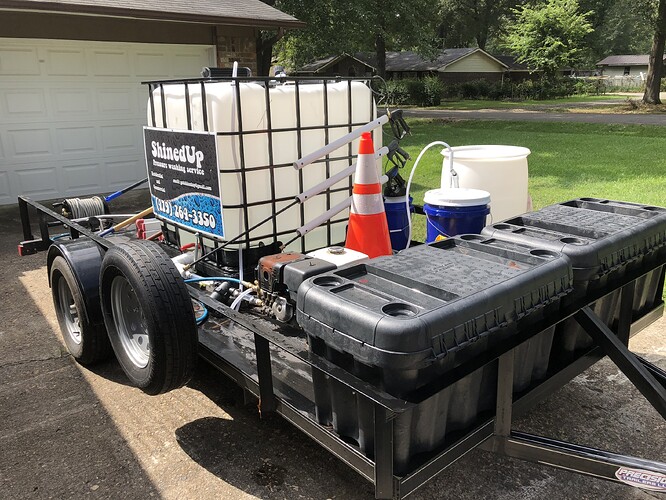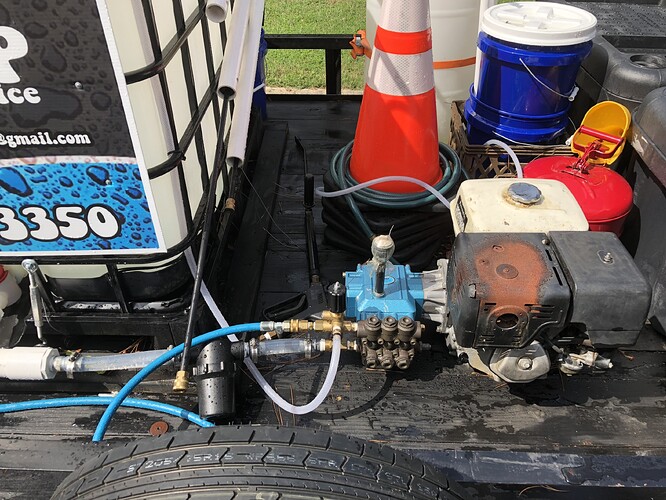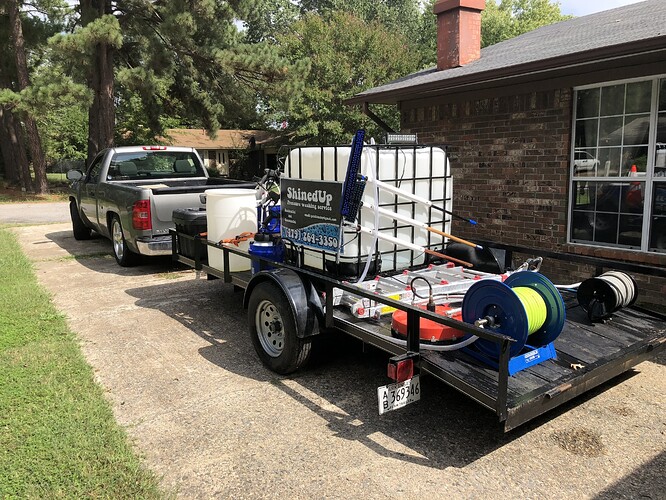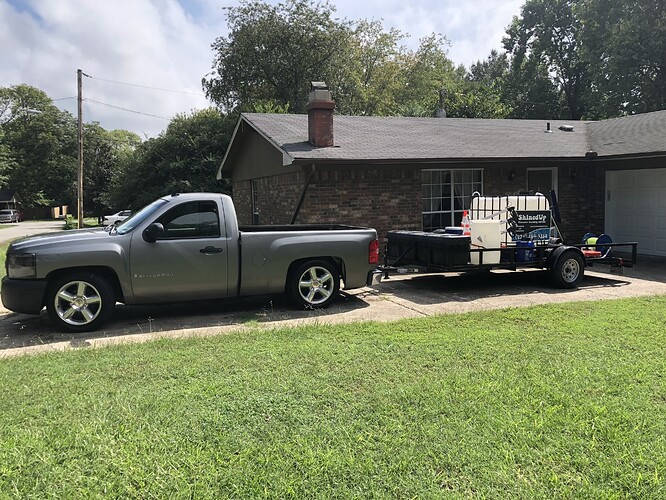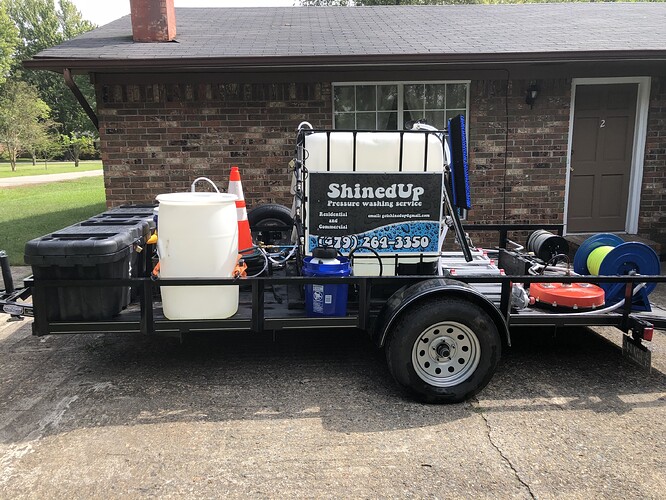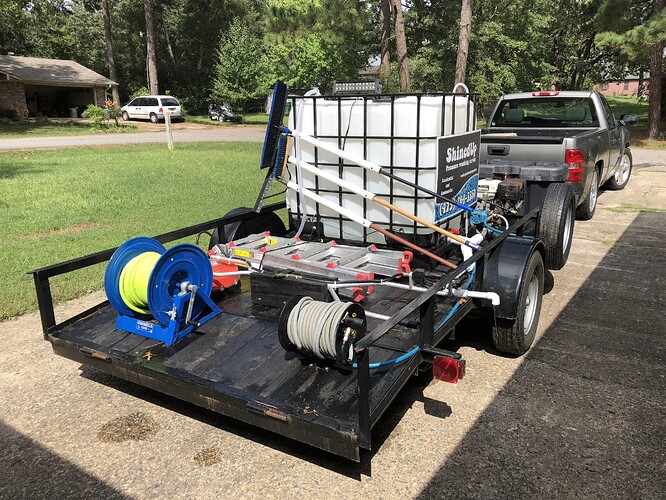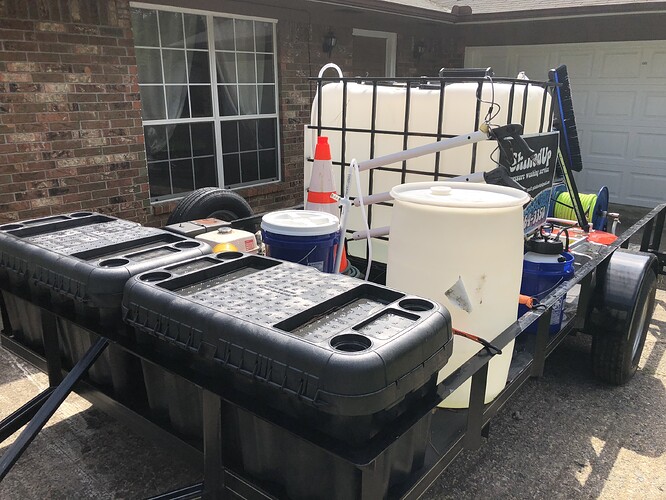Good to know!!
If you’re getting great results with what you’re using then don’t fix what isn’t broken…It’s ok to ask newbie questions here and there…just don’t be like some who post a newbie question every day and expect the pros to answer them. You’ll always get a few to say “use the search”…even I do it sometimes. But nothing wrong with asking about draw ratios.
I personally am successful with as little as .6% hitting the wall…especially on warmer months. When it’s colder you can up it to closer to 1% mix. I’ve started doing 3oz Elemonator and 3oz of Arm/Hammer with Oxy. @Ikii is right…that Arm and Hammer smells amazing and really masks the smell of SH. All I smell is laundry detergent in my garage now just from the cup I use for measureing surfactants.
My 4/4 with a 2.1 injector pulled 9:1 with 200 ft of hose
My 5.6/2500 (actually pulls 6.6gpm) with a 2.1 injector and 200 ft hose pulls 14:1.
that is diluting the SH, what you did is straight math
Now do the math for:
2glSH with 3gl water/surfactant
3glSH with 2gl water/surfactant
4glSH with 1gl water/surfactant
That will be more realistic on the SH % of your mix on a 5gl bucket before DSing
Jerry kafitz explained it to me once. Take a 36oz container filled with water. Put your draw tube in. Hold your gun into a 5 gallon bucket marked to 4 gallons. Start engine, down stream in the five gallon bucket until you reach the 4 gallon mark. Shut off engine. Then take what you’ve used in you’re 36oz container and divide it by your 4 gallons. That’s your ratio. Right?
No…Your draw tube will more than likely pull more than 36 oz of “soap” after 4 gallons of DS…most 4gpm machines with normal equipment and 2.1 injector will pull 8 or 9:1…converting 4 gallons to oz is 512oz / 8 = 64oz pulled so 36oz container won’t work.
The best way I’ve found to measure (I know there’s lot of ways but it works for me) is take a clear gallon “soap” container and mark off increments in cups (8 oz) all the way up to 16 cups and fill with water up to 16 cup line.
Drop your draw line in soap container…DS into 5 gallon bucket for 30 seconds. It’s best if your 5 gallon bucket is marked in gallons or even 1/2 gallon increments.
Measure what’s in 5 gallon bucket. Measure how many cups were pulled from soap container. Convert to oz…times by 2 and you have your ratio.
Example:
DS in bucket after 30 sec…2 gallons x 2 = 4gpm
“Soap” pulled in 30 sec…4 cups x 2 = 8 cups/min
4gpm = 512oz/min minus 8 cups soap = 448oz/min
8 cups soap = 64oz soap/min
448/64 = 7:1 DS injector ratio
10-4 …Thank you. I only have a 3.8 gpm at 3500 psi. I did the test. The result was 17:1 on mine. But you’re way for bigger machines would be better
@Barry1 your right, my setup is working great, but I have been researching for 6-7 months and have soaked up soooooo much information that I second guess everything!! Also I have a nasty habit of never being satisfied and wanting to improve my work. Now I’m no tree hugger, but I do have that lil voice in my head saying “if you can do it as good or better with less chemicals, then do it!” Kinda reminds me of my grandpa saying “ I’ve done so much, for so long, with so little, I’m now qualified to do anything with nothing “. 

@Ikii I’m using straight 12.5 pulling from a 30 gallon drum. I buy the SH in bulk locally. This is where my original post came from, lots of people are saying they dilute their 12.5% BEFORE downstreaming it, and my math tells me that I’m @ approx 0.75% drawing straight 12.5. This is what got me thinking I was missing something!!
My process is working great, but if I can use less chemical to do the same job I’m on that.
I cleaned 8, 4 unit apartment buildings Monday with approximately 12 gallons of SH, and 1/2 gallon of elemonator. That’sonly $37 in chem, but if I could have done it with $30, I should have.
That much lead hose is fine. I only use about 4-5’ of hose on my injector, but I know people use more. Why so far, show us a pic of your setup?
My ds containers set right next to my reels though.
Only way to find out is experiment. Many people have reported satisfactory results at .5-.6% SH. So try diluting your mix to 3 or 4 to 1 and see what happens.
Totally at the risk of offending people, the reason it has been beat to death would be that the answer really does not exist. @MrSparkleVA Actually explained why in several ways. While you may have read a great many mix recipes, all of them are estimated guesses on any given day. Don’t misunderstand, from a liquid drawn vs liquid leaving the gun they may have done significant efforts, however the actual quantity of SH hitting the surface is NEVER going to be as accurate as you seek, nor is there an effective way to give you a number that would indeed be perfect. It simply does not exist. If by chance you really feel the need to determine the draw rate percentage, you need to shift from liquid measurements as the 12.5% number is by weight not volume. 12.5% has a density of about 10.06 pounds per gallon, water is 8.345 in general.
First off, I am not a professional house washer as of this date, however I do know a bit more than the average duck about SH.
When working with SH in the industrial / commercial laundry business which I did for many years, you have to learn how it works and why it works that way because the materials you are applying it to will be destroyed if you don’t do it right. Most of the materials in house washing are not as delicate so there is a ton more wiggle room.
In very general non-technical terms just in case there are any (resident chemist) whom disagree over the grammar employed. SH works by gassing off the chlorine at which point some acids and other fun stuff gets made in the chemical reaction that takes place. Several factors have an effect on the rate at which the chlorine gasses off in the SH mix. The largest factor involved is indeed the percentage of SH, but take note, that relationship is nonlinear it is not even close when in its holding solution with no other factors.
12.5% SH will gas off at about 4 times the rate of 8% sitting on the shelf at the same temp etc. This by the way is a real good reason to make your mix because it will actually stay stronger longer when mixed at the same liquid ratio aka 1 gallon to 4 gallons. it also does tend to really slow down around 5% if kept cool and dark.
Some factors contributing to the chlorine gassing off the SH in no special order:
PH
Temp
Light
Organic matter
Note the organic matter is exactly what you are removing from the house so in some respects, the “dirtier” the house, the faster the SH is likely to work.
In the laundry business for a location such as nursing home or hospital where significant amounts of organic matter are on the fabrics you have to account for it. This means you program the machine to rinse usually 2 times, detergent and break, then the chlorine cycle so you have removed most of the organics from the equations and can better control the gas off rate of the SH. You also add chems to tweak the PH level and adjust the temperature to that you chlorinate throughout the entire cycle without burning up all the fabrics.
In house washing you have almost no control over any of the factors, not even the PH really as muni water systems vary from about 6.9 to 8 but one can pretty much depend on 7.2 to 7.8 unless it is a well. It is very rare to see anything below 6.9. The only place I have come across 8 was a plant that used synthetic lime to PH adjust for the water chlorine injection system.
So many folks use so many different surfactants it would require titration of your water surfactant mix and PH testing to get the “perfect mix” of SH to add just to remain chemically consistent, These are indeed steps one takes in commercial industrial laundering when using SH where you can control the temperature and organics loading as well. There is simply not a good method to do this house washing, way too many variables that indeed DO CHANGE with the right and left side of the house.
Can you determine the exact amount of SH and water needed to gas off and break down 1 pound of a specific organic and the perfect anionic surfactant to slip it from the surface, sure, you just have to decide which organic, what surface, what surface temp, what water temp, what water PH, what water totally dissolved solids, make up of the metals in those TDS, SH % and PH. That will give you the perfect chemical part of the cleaning process, the best temperature and mechanical action involved would need to be determined first.
If you moved to roofs, most surfactants have salts added to them to get the gel effect, because salts are a byproduct of the chlorine gassing off those salts will require a significant change in your mix.
I mean no insult, what is above is not technically perfect, it is a generality to increase understanding of the process and to understand what you are seeking is not going to be forthcoming. When you consider in the laundry business I can control almost all of the variables, Time, Temperature, mechanical action, chemical action and to some degree soil levels it becomes even more apparent: I still get stains outside of the “perfect mix” capacity.
Someone mentioned a 3 to 6 minute dwell time, from my perspective that sounds like a real good method for adjusting your chemical action part of the cleaning process. Any less you are wasting product, any more and you risk redepositing the soils on the surface and they will be harder to remove in the next pass.
Good luck in finding what works best for you sir.
@Racer my drums and pump are in the front of the trailer, and the reels are in the ver back. It’s a 14’ trailer. I’ll get some pics this afternoon, I work nights and just woke up! 
@LMTD you sir, are a wealth of useless information, that I find VERY useful!! Thank you for that! All that knowledge from washing dirty sheets, I love it!
Thank you, considering some of the other information I see getting shared, thanks for the compliment.
BTW I didn’t wash the sheets, I was the tech rep for the chemical company supplying the injection systems and chemicals. They are a little bitty company, only doing about 14 billion a year in sales.
good luck
It was definitely a compliment!
There’s others on this forum that don’t do house washing but they have knowledge that can useful. You’re correct that you can never accurately tell that what percentage of SH that’s hitting the surface. That’s why we use more simple mixing methods of “if it’s not working, just add more until it does”. You can try and get precise however SH loses its potency overtime so with a fresh batch I dilute it more…then after 2 weeks I dilute it less…if I still have some after 3 weeks to a month I’m DS usually straight with no dilution.
It is important to know what ratio your injector is pulling and you can go from there as far as strength of mix.
@LMTD I wasn’t trying to say you were washing sheets, just that your knowledge was related to that! 
Nice rig and trailer.
According to the useless information from above, you are running at 0.0082817439 which I believe is a bit closer the the 1% than you thought you were sir.
At 83 ppm and getting the results you like there is not much room to change. You could try for 50 ppm and see if you are happy with it. I wouldn’t bother going below that as SH is not real effective below that.
Good luck
@LMTD Thanks! and your most likely right…
One of my original questions was how the manufacturers/retailers are refering to their injectors. Why would they advertise @ 20% ? id love to buy a 20% downstream injector, 1 gal to 4 gallons!
